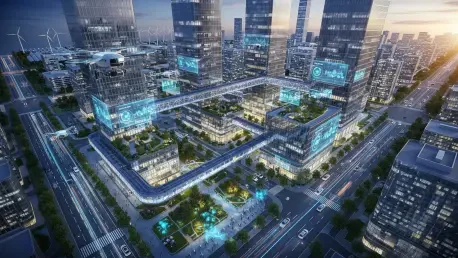The scale of urban challenges today is staggering, with over half of the global population residing in cities, a figure projected to reach nearly 70% by 2050, and this rapid urbanization strains infrastructure, exacerbates traffic congestion, and intensifies resource scarcity, demanding innovative solutions. Smart city technologies have emerged as a transformative force, leveraging digital tools to enhance efficiency, safety, and sustainability in urban environments. This review delves into the core components, recent advancements, and real-world applications of these technologies, shedding light on their potential to redefine how cities operate and thrive amid growing pressures.
Core Components of Smart City Technologies
IoT and Sensor Networks
At the heart of smart city frameworks lies the Internet of Things (IoT), a network of interconnected devices that collect and transmit data in real time. These systems, paired with sensor networks, monitor critical urban functions such as traffic flow, energy usage, and waste management. For instance, sensors embedded in roadways can detect congestion patterns, enabling dynamic adjustments to traffic signals and reducing delays. Their ability to provide continuous feedback is pivotal in creating responsive infrastructures that adapt to immediate needs.
The performance of IoT and sensor networks hinges on their scalability and reliability. Advanced deployments in cities have shown significant improvements in resource allocation, with some municipalities reporting up to a 20% reduction in energy consumption through smart lighting systems. However, challenges like network latency and data overload persist, underscoring the need for robust connectivity solutions to sustain their effectiveness across sprawling urban landscapes.
Data Analytics and AI Systems
Complementing IoT, data analytics and artificial intelligence (AI) serve as the analytical backbone of smart cities, processing vast streams of data to inform decision-making. These systems can predict traffic bottlenecks, optimize public transit routes, and even forecast emergency scenarios by analyzing historical and real-time inputs. Their technical prowess lies in machine learning algorithms that continuously refine predictions based on evolving patterns.
The real-world impact of AI in urban settings is evident in applications like predictive policing, where algorithms identify high-risk areas to allocate resources efficiently. Performance metrics often highlight faster response times and reduced operational costs, though the accuracy of these systems depends heavily on data quality. Ensuring unbiased datasets remains a critical focus to maximize their utility and public trust.
Recent Innovations and Trends
Smart city technologies are evolving rapidly, driven by breakthroughs in 5G connectivity that enable faster, more reliable data transmission. This leap forward supports edge computing, where data processing occurs closer to its source, slashing latency and enhancing system responsiveness. Such advancements are crucial for applications requiring split-second decisions, like autonomous vehicle navigation in dense urban zones.
Emerging trends also point to blockchain as a tool for secure data sharing, protecting sensitive information in public systems. Additionally, there is a noticeable surge in investments toward digital infrastructure, with many governments prioritizing sustainability through tech-driven policies. Citizen engagement platforms are gaining traction as well, empowering residents to contribute to urban planning via mobile apps and digital forums.
A significant shift in urban policy reflects a commitment to long-term ecological goals, with cities integrating renewable energy monitoring into smart grids. This alignment of technology and sustainability signals a broader movement toward creating urban spaces that not only function efficiently but also prioritize environmental stewardship. The momentum of these innovations suggests a dynamic future for urban tech landscapes.
Real-World Applications
Smart city technologies are already reshaping urban sectors, notably in transportation, where real-time traffic management systems alleviate congestion during peak times. In cities like Atlanta, these tools have proven invaluable during large events, coordinating vehicle flow for hundreds of thousands of visitors with minimal disruption. Such implementations demonstrate how data-driven solutions can enhance mobility on a massive scale.
Public safety benefits immensely from integrated communication systems, especially in high-traffic venues like stadiums during major gatherings. Instant notification platforms alert authorities and attendees to potential hazards, ensuring swift crowd control and emergency response. These systems have bolstered security measures, providing a safer environment for urban dwellers and visitors alike.
Resource management also sees transformative impacts, with smart water and energy grids optimizing usage through precise monitoring. Cities employing these technologies report reduced waste and lower utility costs, directly benefiting both municipal budgets and residents. These practical deployments underline the tangible value of smart tech in addressing everyday urban challenges.
Challenges and Limitations in Adoption
Despite their promise, smart city technologies face significant hurdles in widespread adoption, starting with interoperability issues among diverse systems. Many existing infrastructures lack standardization, complicating the integration of new tools and leading to fragmented implementations. This technical barrier often delays the realization of a fully cohesive smart urban network.
High implementation costs pose another obstacle, particularly for smaller municipalities with limited budgets. The upfront investment in hardware, software, and training can be prohibitive, even if long-term savings are evident. Coupled with this are data privacy concerns, as the collection of vast personal information raises questions about surveillance and security in public spaces.
Regulatory challenges further complicate deployment, with varying local laws creating inconsistent frameworks for technology use. Public resistance, often fueled by fears of overreach, adds to the complexity, necessitating transparent governance to build trust. Efforts are underway to develop scalable, secure solutions, but overcoming these multifaceted barriers requires coordinated action across sectors.
Future Outlook
Looking ahead, smart city technologies are poised for groundbreaking advancements, particularly with deeper AI integration that could refine urban systems to unprecedented levels of precision. Predictive models may evolve to anticipate infrastructure needs years in advance, enabling proactive rather than reactive planning. Such capabilities could redefine how cities prepare for growth and crises.
The incorporation of renewable energy systems into smart grids also holds immense potential, supporting urban resilience against climate challenges. As global urbanization accelerates, these technologies could drive economic growth by creating tech-centric job markets and fostering innovation hubs. Their role in enhancing societal well-being through improved services cannot be overstated.
Over the next few years, from 2025 to 2030, expect a surge in pilot projects testing hybrid models of smart tech and traditional urban planning. International collaboration will likely play a key role, with cities sharing best practices to tackle common issues like resource scarcity. This trajectory points to a future where smart cities are not just a concept but a fundamental aspect of global urban life.
Final Thoughts
Reflecting on the journey of smart city technologies, their transformative impact stands out as a beacon for urban progress, reshaping how cities manage complexity with digital precision. The strides made in IoT, AI, and connectivity have already begun to redefine efficiency and safety in urban spaces. Challenges like cost and privacy have presented formidable hurdles, yet the relentless pace of innovation offers hope for resolution. Moving forward, stakeholders should prioritize scalable solutions, invest in public education to ease adoption, and foster global partnerships to share insights. By focusing on inclusive policies and sustainable tech, the legacy of these advancements could ensure cities evolve into resilient, equitable hubs for generations to come.









